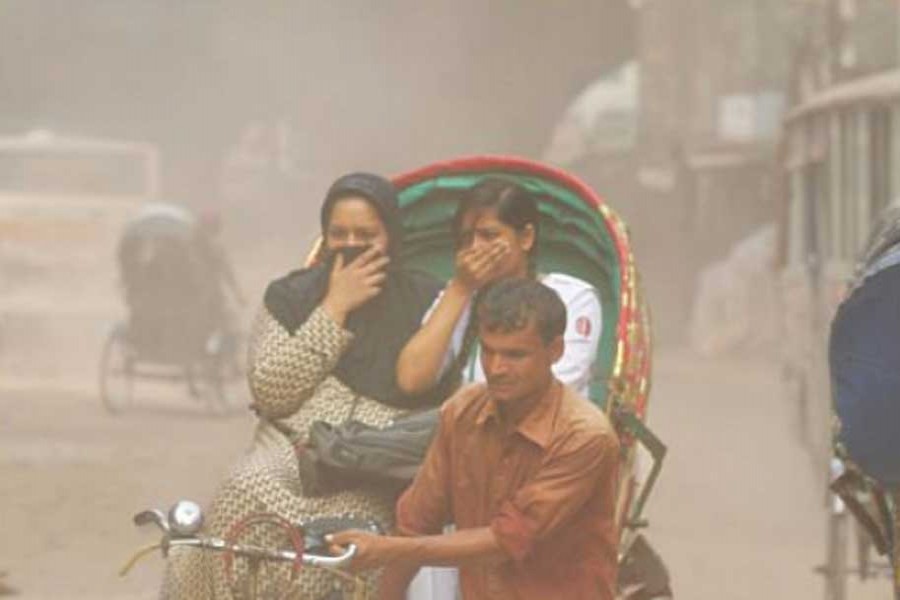What the World Bank (WB) report has divulged on urban pollution in Bangladesh is far scarier than it is perceived, often expressed in vague and unquantified terms. Focusing on the cost of environmental degradation, clean and resilient cities, and institutions for clean industrial growth the WB report shows that pollution is more than a silent killer in Bangladesh. Besides costing the economy dearly, impact on human life and environment is frighteningly high.
The WB report 'Enhancing Opportunities for Clean and Resilient Growth in Urban Bangladesh: Country Environmental Analysis 2018', released in a city hotel this week, claims that Bangladesh loses about US$ 6.5 billion due to pollution and environmental degradation in its urban areas every year, making it the worst case of environmental degradation and pollution. The amount is equivalent to 3.4 per cent of the country's Gross Domestic Product (GDP) in 2015, said the report.
The economic cost of mortality in terms of foregone labour output is estimated at $ 1.40 billion in the urban areas, which is equivalent to 0.7 per cent of Bangladesh's GDP in that year. Of the foregone labour output, $310 million, equivalent to 0.2 per cent of GDP, is estimated to have incurred in Dhaka alone, the WB report revealed. The report says pollution, which has reached an alarming level, caused about 80,000 deaths in the cities in 2015. Twenty-one per cent of all deaths were from diseases caused by pollution across the country, compared to the global average of 16 per cent.
The report has highlighted air pollution as the leading environmental risk in Bangladesh, causing about 21 per cent of all deaths in the country. It further adds, nearly one million people in the country, mostly poor, are at risk of lead contamination, which can cause neurological damage, especially for children, and can also increase the risk of miscarriage and stillbirth among pregnant women. Based on data gathered from 11 air quality monitoring stations in eight urban areas, concentration of 2.5 microgram particulate matter in the air was found to be five times the Bangladesh standard and eight times the World Health Organisation standard.
Clearly, it is urbanisation and industrial growth (both unplanned for the most part) that have come with high costs. Over the past thirty years or so, there has been dramatic increase in pollution linked to urbanisation in the country. Rapid growth of garment industry and increase in urban population from less than 40 million in 2006 to more than 55 million in 2015 have been the key factors in exposing the growing urban population to environmental hazards.
Environmentalists, town planners and the media have for long been focusing on the issue demanding, among other things, strict enforcement mechanism to contain the disastrous impact on environment and human life. There were moves, albeit lax and uncommitted, that fell far short of arresting the problem. The wastes generated by garment factories and the leather industry are cases in point. Although the garment sector plays an important role in driving the national economy, the WB report says the sector produces 2.81 million tonnes of wastes a year. As for the leather sector, we hardly need to recap the proceedings of the past few years, including the inordinately long shifting process of the leather hub from Hazaribagh to Savar leather estate, which in reality has led to shifting the pollution zone from the previous location to the new one. Earlier, it was the river Buriganga dying from corrosive leather wastes, now it is Dhaleshawri choking from the discharge of caustic wastes. The effluent treatment plant meant to recycle the wastes in the leather estate has run into snags.
The overall pollution situation in the country is, no doubt, an outcome of colossal neglect for a long period of time. Just as the WB report has pointed out that the country's 75 per cent wetlands and canals got narrowed by encroachments for over forty years. As a result, 41 per cent flood flow zones and 21 per cent water retention areas in Dhaka got filled up. Due to lack of waste disposal system, wetlands and canals have become dumping ground for wastes and garbage. In this context, the report particularly stresses on conservation of wetlands and rivers, and scaling up efforts to conserve the mangroves and other forest resources.
The report, based on findings in three cities -- Dhaka, Cox's Bazar and Pabna called for using improved technology and practices in different industries, especially in textile, power and infrastructure sectors. It also stressed for more collaboration between the public and the private sectors in this regard. It observed that weak institutional capacity of the enforcement agencies concerned, such as Department of Environment (DoE), and insufficient engagement of other key players are largely responsible for the unabated environmental pollution.
The WB report has not only given a vivid picture of urban pollution in the country but also made the case for its control quite strongly. There are important cues in the report that the government, non-governmental organisations (NGOs) and environmentalists can take to deal with the situation. The findings will be helpful to all concerned. However, at the end of the day, it is the government that has to engage itself vigorously -- with the conviction that it is a winnable battle.


